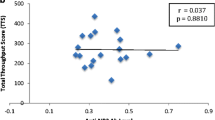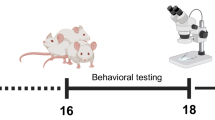Abstract
Excessive influx of immunoglobulin (IgG) into the brain has been reported to induce central nervous system (CNS) dysfunction. Depressed patients may exhibit immune activation manifested by elevated inflammatory markers and pro-inflammatory cytokines. The brain and especially the limbic system contain high concentrations of high affinity Fc receptors. We reviewed the literature on this phenomena and present data on the behavioral effects of pooled normal IgG on the brain. Many disease states are associated with depression and we examined whether this may be linked to high IgG influx. Female Balb/C mice were injected intra-cerbroventricularly with human immunoglobulin whole molecule, or human IgG F(ab′)2 or Fc fragments. Control mice were injected with saline. The four groups were subjected to behavioral (staircase, forced swimming test, and elevated plus maze) and cognitive tests (passive avoidance test). IgG-injected mice exhibited depression-like behavior as reflected by significantly higher immobility time in the forced swimming test (p < 0.05) and hyperactive behavior as reflected by higher number of stairs climbed in the staircase test compared to controls (p < 0.01). Fc-fragments-injected mice showed hyperactive behavior as reflected by both higher number of stairs climbed and rearing events in the staircase test compared to controls. The results indicate that high levels of normal IgG in the cerebrospinal fluid can cause hyperactivity and depression-like behavior. The mechanism involved in these CNS manifestations include possibly Fc receptor binding.
Similar content being viewed by others
References
Bien CG, Vincent A, Barnett MH et al (2012) Immunopathology of autoantibody-associated encephalitides: clues for pathogenesis. Brain 135:1622–1638
Kaida K, Kusunoki S (2010) Antibodies to gangliosides and ganglioside complexes in Guillain-Barre syndrome and Fisher syndrome: mini-review. J Neuroimmunol 223:5–12
Zandman-Goddard G, Chapman J, Shoenfeld Y (2007) Autoantibodies involved in neuropsychiatric SLE and antiphospholipid syndrome. Semin Arthritis Rheum 36:297–315
Peeters M, Joossens S, Vermeire S, Vlietinck R, Bossuyt X, Rutgeerts P (2001) Diagnostic value of anti-Saccharomyces cerevisiae and antineutrophil cytoplasmic autoantibodies in inflammatory bowel disease. Am J Gastroenterol 96:730–734
Luborsky JL, Barua A, Shatavi SV, Kebede T, Abramowicz J, Rotmensch J (2005) Anti-tumor antibodies in ovarian cancer. Am J Reprod Immunol 54:55–62
Zhong L, Peng X, Hidalgo GE, Doherty DE, Stromberg AJ, Hirschowitz EA (2004) Identification of circulating antibodies to tumor-associated proteins for combined use as markers of non-small cell lung cancer. Proteomics 4:1216–1225
Melendez AJ, Bruetschy L, Floto RA, Harnett MM, Allen JM (2001) Functional coupling of FcgammaRI to nicotinamide adenine dinucleotide phosphate (reduced form) oxidative burst and immune complex trafficking requires the activation of phospholipase D1. Blood 98:3421–3428
Stangel M, Compston A (2001) Polyclonal immunoglobulins (IVIg) modulate nitric oxide production and microglial functions in vitro via Fc receptors. J Neuroimmunol 112:63–71
Sanchez-Mejorada G, Rosales C (1998) Signal transduction by immunoglobulin Fc receptors. J Leukoc Biol 63:521–533
Ravetch JV, Kinet JP (1991) Fc receptors. Annu Rev Immunol 9:457–492
van de Winkel JG, Capel PJ (1993) Human IgG Fc receptor heterogeneity: molecular aspects and clinical implications. Immunol Today 14:215–221
Nakamura K, Hirai H, Torashima T et al (2007) CD3 and immunoglobulin G Fc receptor regulate cerebellar functions. Mol Cell Biol 27:5128–5134
Suemitsu S, Watanabe M, Yokobayashi E et al (2010) Fcgamma receptors contribute to pyramidal cell death in the mouse hippocampus following local kainic acid injection. Neuroscience 166:819–831
Namer IJ, Steibel J, Poulet P, Mauss Y, Mohr M, Chambron J (1994) The role of Mycobacterium tuberculosis in experimental allergic encephalomyelitis. Eur Neurol 34:224–227
Walls AF, Suckling AJ, Rumsby MG (1988) Autoantibody responses in the cerebrospinal fluid of guinea pigs with chronic relapsing experimental allergic encephalomyelitis. Acta Neurol Scand 78:422–428
Kamm C, Zettl UK (2012) Autoimmune disorders affecting both the central and peripheral nervous system. Autoimmun Rev 11:196–202
Chavarria A, Alcocer-Varela J (2004) Is damage in central nervous system due to inflammation? Autoimmun Rev 3:251–260
Rabchevsky AG, Degos JD, Dreyfus PA (1999) Peripheral injections of Freund’s adjuvant in mice provoke leakage of serum proteins through the blood–brain barrier without inducing reactive gliosis. Brain Res 832:84–96
Shrot S, Katzav A, Korczyn AD et al (2002) Behavioral and cognitive deficits occur only after prolonged exposure of mice to antiphospholipid antibodies. Lupus 11:736–743
Holmes GP, Kaplan JE, Gantz NM et al (1988) Chronic fatigue syndrome: a working case definition. Ann Intern Med 108:387–389
Lorusso L, Mikhaylova SV, Capelli E, Ferrari D, Ngonga GK, Ricevuti G (2009) Immunological aspects of chronic fatigue syndrome. Autoimmun Rev 8:287–291
Hokama Y, Empey-Campora C, Hara C et al (2008) Acute phase phospholipids related to the cardiolipin of mitochondria in the sera of patients with chronic fatigue syndrome (CFS), chronic Ciguatera fish poisoning (CCFP), and other diseases attributed to chemicals, Gulf War, and marine toxins. J Clin Lab Anal 22:99–105
Konstantinov K, von Mikecz A, Buchwald D, Jones J, Gerace L, Tan EM (1996) Autoantibodies to nuclear envelope antigens in chronic fatigue syndrome. J Clin Invest 98:1888–1896
Wheatland R (2005) Chronic ACTH autoantibodies are a significant pathological factor in the disruption of the hypothalamic–pituitary–adrenal axis in chronic fatigue syndrome, anorexia nervosa and major depression. Med Hypotheses 65:287–295
Vernon SD, Reeves WC (2005) Evaluation of autoantibodies to common and neuronal cell antigens in Chronic Fatigue Syndrome. J Autoimmune Dis 2:5
Klein R, Berg PA (1995) High incidence of antibodies to 5-hydroxytryptamine, gangliosides and phospholipids in patients with chronic fatigue and fibromyalgia syndrome and their relatives: evidence for a clinical entity of both disorders. Eur J Med Res 1:21–26
Heller U, Becker EW, Zenner HP, Berg PA (1998) Incidence and clinical relevance of antibodies to phospholipids, serotonin and ganglioside in patients with sudden deafness and progressive inner ear hearing loss. HNO 46:583–586
Feinstein A (2011) Multiple sclerosis and depression. Mult Scler 17:1276–1281
Luque FA, Jaffe SL (2007) Cerebrospinal fluid analysis in multiple sclerosis. Int Rev Neurobiol 79:341–356
Chapman J, Abu-Katash M, Inzelberg R et al (2002) Prevalence and clinical features of dementia associated with the antiphospholipid syndrome and circulating anticoagulants. J Neurol Sci 203–204:81–84
Bluestein HG, Williams GW, Steinberg AD (1981) Cerebrospinal fluid antibodies to neuronal cells: association with neuropsychiatric manifestations of systemic lupus erythematosus. Am J Med 70:240–246
Danon YL, Garty BZ (1986) Autoantibodies to neuroblastoma cell surface antigens in neuropsychiatric lupus. Neuropediatrics 17:23–27
Katzav A, Shoenfeld Y, Chapman J (2010) The pathogenesis of neural injury in animal models of the antiphospholipid syndrome. Clin Rev Allergy Immunol 38:196–200
Liberato B, Levy RA (2007) Antiphospholipid syndrome and cognition. Clin Rev Allergy Immunol 32:188–191
Katzav A, Pick CG, Korczyn AD et al (2001) Hyperactivity in a mouse model of the antiphospholipid syndrome. Lupus 10:496–499
Omdal R, Brokstad K, Waterloo K, Koldingsnes W, Jonsson R, Mellgren SI (2005) Neuropsychiatric disturbances in SLE are associated with antibodies against NMDA receptors. Eur J Neurol 12:392–398
Peery HE, Day GS, Dunn S, et al (2012) Anti-NMDA receptor encephalitis. The disorder, the diagnosis and the immunobiology. Autoimmun Rev 11:863–872
D’Andrea MR (2005) Add Alzheimer’s disease to the list of autoimmune diseases. Med Hypotheses 64:458–463
Sardi F, Fassina L, Venturini L et al (2011) Alzheimer’s disease, autoimmunity and inflammation. The good, the bad and the ugly. Autoimmun Rev 11:149–153
D’Andrea MR (2005) Evidence that immunoglobulin-positive neurons in Alzheimer’s disease are dying via the classical antibody-dependent complement pathway. Am J Alzheimers Dis Other Demen 20:144–150
Ryu JK, McLarnon JG (2009) A leaky blood–brain barrier, fibrinogen infiltration and microglial reactivity in inflamed Alzheimer’s disease brain. J Cell Mol Med 13:2911–2925
Colasanti T, Barbati C, Rosano G, Malorni W, Ortona E (2010) Autoantibodies in patients with Alzheimer’s disease: pathogenetic role and potential use as biomarkers of disease progression. Autoimmun Rev 9:807–811
Chapman J, Alroy G, Weiss Z, Faigon M, Feldon J, Michaelson DM (1991) Anti-neuronal antibodies similar to those found in Alzheimer’s disease induce memory dysfunction in rats. Neuroscience 40:297–305
Chapman J, Feldon J, Alroy G, Michaelson DM (1989) Immunization of rats with cholinergic neurons induces behavioral deficits. J Neural Transplant 1:63–76
Benkler M, Agmon-Levin N, Hassin-Baer S et al (2012) Immunology, autoimmunity, and autoantibodies in Parkinson’s disease. Clin Rev Allergy Immunol 42:164–171
Belmaker RH, Agam G (2008) Major depressive disorder. N Engl J Med 358:55–68
Hasin DS, Goodwin RD, Stinson FS, Grant BF (2005) Epidemiology of major depressive disorder: results from the National Epidemiologic Survey on Alcoholism and Related Conditions. Arch Gen Psychiatry 62:1097–1106
Dowlati Y, Herrmann N, Swardfager W et al (2010) A meta-analysis of cytokines in major depression. Biol Psychiatry 67:446–457
Gohier B, Goeb JL, Rannou-Dubas K, Fouchard I, Cales P, Garre JB (2003) Hepatitis C, alpha interferon, anxiety and depression disorders: a prospective study of 71 patients. World J Biol Psychiatry 4:115–118
Howren MB, Lamkin DM, Suls J (2009) Associations of depression with C-reactive protein, IL-1, and IL-6: a meta-analysis. Psychosom Med 71:171–186
Kronfol Z (2002) Immune dysregulation in major depression: a critical review of existing evidence. Int J Neuropsychopharmacol 5:333–343
Kronfol Z, House JD (1989) Lymphocyte mitogenesis, immunoglobulin and complement levels in depressed patients and normal controls. Acta Psychiatr Scand 80:142–147
Maes M (1995) Evidence for an immune response in major depression: a review and hypothesis. Prog Neuropsychopharmacol Biol Psychiatry 19:11–38
Maes M, Scharpe S, Meltzer HY et al (1993) Relationships between interleukin-6 activity, acute phase proteins, and function of the hypothalamic–pituitary–adrenal axis in severe depression. Psychiatry Res 49:11–27
Valentine AD, Meyers CA, Kling MA, Richelson E, Hauser P (1998) Mood and cognitive side effects of interferon-alpha therapy. Semin Oncol 25:39–47
Dantzer R, O’Connor JC, Freund GG, Johnson RW, Kelley KW (2008) From inflammation to sickness and depression: when the immune system subjugates the brain. Nat Rev Neurosci 9:46–56
Kent S, Bluthe RM, Kelley KW, Dantzer R (1992) Sickness behavior as a new target for drug development. Trends Pharmacol Sci 13:24–28
Fantuzzi G, Dinarello CA (1996) The inflammatory response in interleukin-1 beta-deficient mice: comparison with other cytokine-related knock-out mice. J Leukoc Biol 59:489–493
Krueger JM, Majde JA, Obal F (2003) Sleep in host defense. Brain Behav Immun 17(Suppl 1):S41–S47
Swiergiel AH, Smagin GN, Johnson LJ, Dunn AJ (1997) The role of cytokines in the behavioral responses to endotoxin and influenza virus infection in mice: effects of acute and chronic administration of the interleukin-1-receptor antagonist (IL-1ra). Brain Res 776:96–104
Adler G, Gattaz WF (1993) Pain perception threshold in major depression. Biol Psychiatry 34:687–689
Watkins LR, Wiertelak EP, Goehler LE, Smith KP, Martin D, Maier SF (1994) Characterization of cytokine-induced hyperalgesia. Brain Res 654:15–26
Song X, Shapiro S, Goldman DL, Casadevall A, Scharff M, Lee SC (2002) Fcgamma receptor I- and III-mediated macrophage inflammatory protein 1alpha induction in primary human and murine microglia. Infect Immun 70:5177–5184
Song X, Tanaka S, Cox D, Lee SC (2004) Fcgamma receptor signaling in primary human microglia: differential roles of PI-3K and Ras/ERK MAPK pathways in phagocytosis and chemokine induction. J Leukoc Biol 75:1147–1155
Lunnon K, Teeling JL, Tutt AL, Cragg MS, Glennie MJ, Perry VH (2011) Systemic inflammation modulates Fc receptor expression on microglia during chronic neurodegeneration. J Immunol 186:7215–7224
Hastings RS, Parsey RV, Oquendo MA, Arango V, Mann JJ (2004) Volumetric analysis of the prefrontal cortex, amygdala, and hippocampus in major depression. Neuropsychopharmacol 29:952–959
Mayberg HS, Lozano AM, Voon V et al (2005) Deep brain stimulation for treatment-resistant depression. Neuron 45:651–660
Heo Y, Zhang Y, Gao D, Miller VM, Lawrence DA (2011) Aberrant immune responses in a mouse with behavioral disorders. PLoS One 6:e20912
Katzav A, Solodeev I, Brodsky O et al (2007) Induction of autoimmune depression in mice by anti-ribosomal P antibodies via the limbic system. Arthritis Rheum 56:938–948
Kivity S, Katz U, Daniel N, Nussinovitch U, Papageorgiou N, Shoenfeld Y (2010) Evidence for the use of intravenous immunoglobulins—a review of the literature. Clin Rev Allergy Immunol 38:201–269
Sapir T, Shoenfeld Y (2005) Facing the enigma of immunomodulatory effects of intravenous immunoglobulin. Clin Rev Allergy Immunol 29:185–199
Kaveri SV (2012) Intravenous immunoglobulin: exploiting the potential of natural antibodies. Autoimmun Rev 11:792–794
Author information
Authors and Affiliations
Corresponding author
Rights and permissions
About this article
Cite this article
Menachem, A., Chapman, J., Deri, Y. et al. Immunoglobulin-Mediated Neuro-Cognitive Impairment: New Data and a Comprehensive Review. Clinic Rev Allerg Immunol 45, 248–255 (2013). https://doi.org/10.1007/s12016-013-8357-z
Published:
Issue Date:
DOI: https://doi.org/10.1007/s12016-013-8357-z




